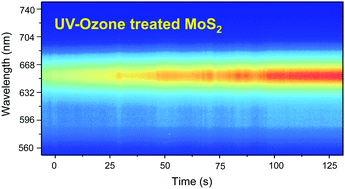Defect-engineered MoS2 with extended photoluminescence lifetime for high-performance hydrogen evolution†
Abstract
It has been reported that defects in molybdenum disulfide (MoS2) enable the hydrogen evolution reaction (HER). The most widely employed method of argon-plasma treatment for defect generation suffers from poor material stability and loss of conductivity. Here, we report a new method to synthesize highly polycrystalline molybdenum disulfide MoS2 bilayers with enhanced HER performance and material stability. This new method is based on metal organic chemical vapor deposition (MOCVD) followed by UV/ozone treatment to generate defects. The defect densities on MoS2 were identified by the increase in lifetime (∼76%) and intensity (∼15%) in photoluminescence (PL) as compared to those of pristine MoS2. Our fabrication and characterization methods can be further applied to optimize defect densities for catalytic effects in various transition metal dichalcogenide (TMDC) materials.



 Please wait while we load your content...
Please wait while we load your content...